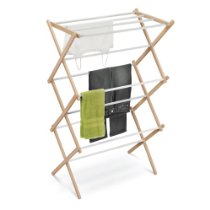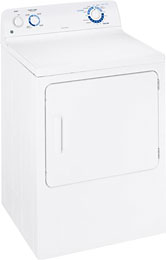When my 15-year-old clothes dryer conked out recently, I knew I wanted to replace it with the most energy-efficient dryer available that would meet my family of three’s laundry needs. We probably do three full loads of laundry a week, plus towels and sheets. It’s not as much as when the kids were little and I was washing their cloth diapers at home, but it is still a significant amount of laundry. I wanted an energy-saving clothes dryer not just because I wanted to use less energy (which I do), but also because I wanted to save money on my energy bills. Here are some of the best options I found.
Energy-Saving Clothes Dryer Alternatives

Clothesline – I would gladly put up a clothes line if my yard were closer to my laundry room. Many people in my neighborhood use an outdoor clothesline; it’s certainly what I grew up with as a kid. But my washer and dryer are on the second floor of my house, and my yard is way below the house. It would be somewhat backbreaking to lug my laundry basket all the way down to a clothesline in the yard. Still, if your laundry room is on ground level, it could save you a lot of energy and money to hang your laundry to dry on the line rather than throw it in a dryer.
Gas vs. Electric?
Natural gas dryers are generally more efficient than electric; they also generate fewer climate change emissions than electricity if the electricity is supplied by burning coal. Unfortunately, I didn’t have much choice here, as the old dryer was electric and it would have cost a fortune to run a gas line up to my second floor to power a new dryer.
So my question became, which electric dryer would be most efficient? According to EPA, a clothes dryer can consume over 4% of a home’s energy usage, a significant amount. Normally, I’d compare the Environmental Protection Agency’s Energy STAR appliance ratings to help me choose the most energy-efficient option. But unlike for clothes washers, dish washers, refrigerators, and many other electric appliances, there’s no Energy STAR rating for this category.
My appliance retailer gave me some wise words of advice. “If you want to save energy,” he said, “don’t buy a bigger machine than you really need.” The bigger the dryer, the more energy it would use. “But don’t buy one that’s too small, either,” he warned. “Otherwise, you’ll be running your dryer twice as often to dry the same amount of clothes.”

^ An Auto Dry function that monitors air temperatures to set drying times
^ Very simple controls
^ 4 heat selections (Cottons Regular Heat; Easy Care Medium Heat; Air Fuff No Heat; and Delicates to protect heat-sensitive fabrics and lingerie, all of which have proven more than adequate for our drying needs)
^ A humidity detector, which senses when the laundry is dry and will shut off automatically
^ a Dewrinkle cycle if I want to dry the clothes lightly so they end up less wrinkled
The only feature that we might have wanted but didn’t get is a “cool down setting” which continues to tumble the clothes but not blow hot air around them.
Another advantage was the price. The machine I bought cost less than $500 installed, which was much cheaper than bigger models with more bells and whistles.
Other Ways to Save Energy Using a Clothes Dryer?
We’re pretty happy with this dryer. But we still look for ways we can save energy and money drying our clothes. Here’s how:
* Dry drier clothes. The wetter your clothes are when you take them out of the washing machine, the longer it will take to dry them. We use the top spin cycle on our washer to get as much water out of our laundry as possible before we toss it in the dryer.
* Use the moisture sensor option, rather than timed dry. This way, the machine shuts off automatically when the clothes are dry.
* Air dry as much as possible. We generally hang shirts, blouses, pants and jeans over the shower rod in the bathroom rather than toss them in the dryer. They dry with fewer wrinkles and don’t shrink, so they end up lasting longer than if we tossed them in with everything else.
NOTE: You can find a variety of clothes lines and rack dryer options in our Amazon store here.
RELATED POSTS:














4 thoughts on “How To Pick a New Energy-Saving Clothes Dryer”
Some good alternatives suggested.
I had to chuckle, someone about 20 yrs old saw the dryer rack I had and thought it must be a fancy shoe rack.
I spin my clothes extra before putting them in the dryer too.
More people need to know there are alternatives and ways to save more energy while using less electricity and chemicals to take care of ones clothes.
Jeannie, Is there any way if you can figure out the energy savings by spinning the clothes twice as opposed to the extra drying time? How much less drying time does the extra spinning result in?
I’ve been using the clothesline for a while now and I LOVE it, but there are times when I need the dryer too and I really wish it had the sensor option.
Higher-priced dryers might offer a dozen or so choices. Touchpads look impressive and might allow you to save custom settings but don’t improve performance. Nor do stainless-steel tubs, unlike in washers.
Comments are closed.